The Breakdown of Our Railway
Transportation
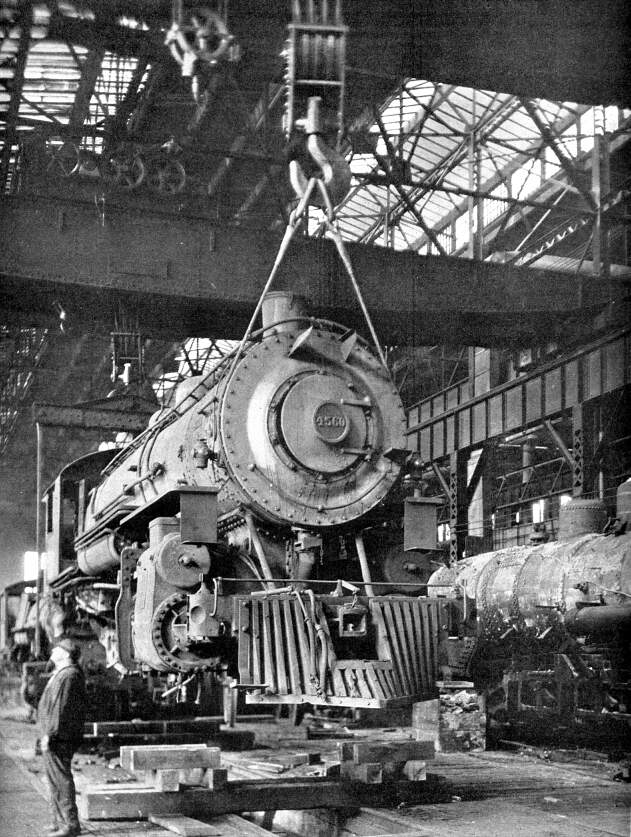 Neglect of Motive Power
Maintenance the Key to the Situation
Neglect of Motive Power
Maintenance the Key to the Situation
Scientific American—June 1, 1918
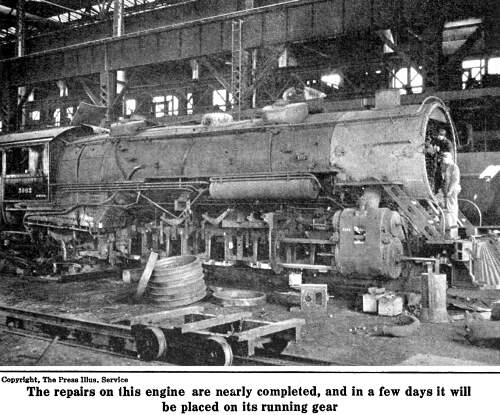 WE who ride in the "varnished
cars" are often at a loss to understand the frequently published
reports that the railroads are unable to handle the supplies that
are not only essential to the existence of the inhabitants of
our cities and towns but as well as for our armies both abroad
and at home. At every terminal point, and scattered at frequent
intervals along the thousands of miles of tracks all over the
country, are seen herds of great locomotives, hissing with steam,
the embodiment of vast pent up power. The boiler is there, the
wheels are all there, nothing seems to be missing from the machinery.
Why can't they get the trains over the road? WE who ride in the "varnished
cars" are often at a loss to understand the frequently published
reports that the railroads are unable to handle the supplies that
are not only essential to the existence of the inhabitants of
our cities and towns but as well as for our armies both abroad
and at home. At every terminal point, and scattered at frequent
intervals along the thousands of miles of tracks all over the
country, are seen herds of great locomotives, hissing with steam,
the embodiment of vast pent up power. The boiler is there, the
wheels are all there, nothing seems to be missing from the machinery.
Why can't they get the trains over the road?
Unfortunately this is also the view taken for many years by
the officials who have been in charge of our railway management.
They are wise in the intricacies of the stock market; they provide
wonderful and luxurious trains for the transportation of their
passengers, but when it comes to the grimy details of the machinery
that keeps the trains moving they have shown most remarkable obtuseness.
The passenger trains are the ones that make the show to the public,
and no expense is spared on them; but it is the unpicturesque
freight train that earns the money, and, strange to say, this
is the direction in which petty economies have been carried to
the extreme, and as long as a freight engine can turn a wheel
it is kept at work, whether it is doing the duty intended, and
of which it is capable, or not.
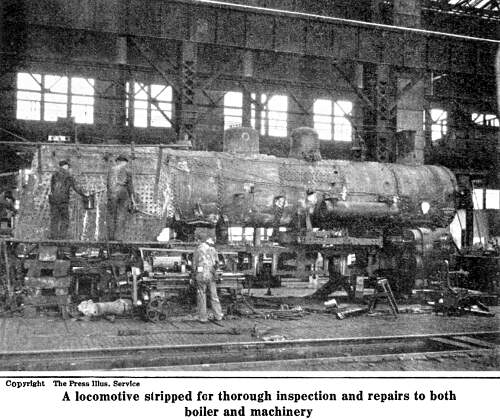 The province of a railroad is to
sell transportation, particularly the transportation of freight,
and to enable it to perform its vital function effectively the
operating machinery should be kept in efficient condition. How
this is not done is in a measure indicated by a report made by
inspectors of the Interstate Commerce Commission last winter;
and one example taken from this report will indicate what inefficiency
in this direction means. At a roundhouse of one road there were
22 locomotives outside waiting for repairs. One of these had been
waiting for four days; and assuming that this engine was capable
of hauling 1,200 tons, when in good order, which is undoubtedly
far below its actual capacity, and also assuming that it would
cover 65 miles a day with its train, which is also a conservative
figure, the delay of four days would mean that the road lost a
service that would have moved 312,000 tons one mile; ton-miles
being the railroad standard for calculating work done. Stating
the case in another way, a mechanical plant costing in the neighborhood
of $50,000 was kept idle four days because the owners had not
provided the facilities for keeping it in operation. Any business
man with manufacturing experience will appreciate what this means.
This of course is considering only the unnecessary waiting time,
without taking into account the time required for the actual repair
work. The province of a railroad is to
sell transportation, particularly the transportation of freight,
and to enable it to perform its vital function effectively the
operating machinery should be kept in efficient condition. How
this is not done is in a measure indicated by a report made by
inspectors of the Interstate Commerce Commission last winter;
and one example taken from this report will indicate what inefficiency
in this direction means. At a roundhouse of one road there were
22 locomotives outside waiting for repairs. One of these had been
waiting for four days; and assuming that this engine was capable
of hauling 1,200 tons, when in good order, which is undoubtedly
far below its actual capacity, and also assuming that it would
cover 65 miles a day with its train, which is also a conservative
figure, the delay of four days would mean that the road lost a
service that would have moved 312,000 tons one mile; ton-miles
being the railroad standard for calculating work done. Stating
the case in another way, a mechanical plant costing in the neighborhood
of $50,000 was kept idle four days because the owners had not
provided the facilities for keeping it in operation. Any business
man with manufacturing experience will appreciate what this means.
This of course is considering only the unnecessary waiting time,
without taking into account the time required for the actual repair
work.
Of course this may be said to be an extreme case, but nevertheless
it is a picture of what has been going on in railroad practice
for years, as can be proven by consulting the files of any publication
devoted to railroad matters for as far back as anyone cares to
go. Of course there are exceptions to this rule, but they are
surprisingly few considering the great number of roads in this
country and the enormous amount of business they are required
to handle. As a rule, however, the provision made for maintaining
the operative machinery would be considered by men on other lines
of business who use machinery as preposterously inadequate.
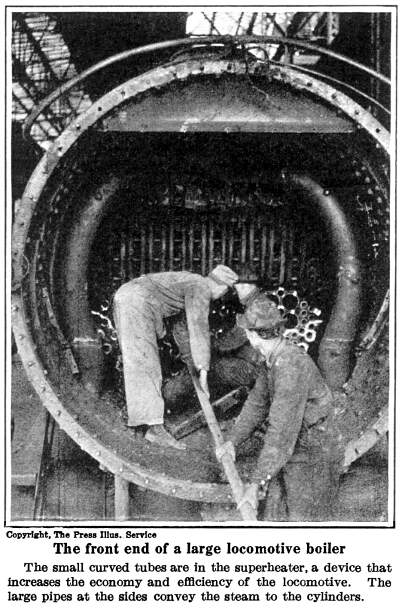 We constantly read glowing statements
of the enterprise of the railroads in buying big engines to handle
their rapidly growing business, but we hear little of the fact
that these same roads have made absolutely no provision for maintaining
these great and enormously expensive machines. Take the case of
the roundhouse, where locomotives are housed for cleaning and
adjustment after a run; very few can be found that will accommodate
one of the newer large engines that are now so generally used,
and as a consequence the doors cannot be closed to protect either
the men or the machine while this necessary work is being done,
and in winter weather both are exposed to bitter cold and driving
snow and rain. Indeed, in many cases it has been necessary to
break out a large portion of the front walls to enable the engine
to get in at all. Under these conditions good work cannot be expected.
The repair shops proper are equally inadequate both in size and
equipment. In a recent issue of the Railway Age, the leading publication
devoted to railroad matters, the statement was made that "One
road owning over 2,000 locomotives estimates that its repair facilities
can only be brought up to the proper standard by an expenditure
of over $10,000,000. Another road operating about 1,500 locomotives
has only repair facilities for 750 and these are old shops with
inadequate facilities." The same authority estimates that
60 per cent of the locomotives of the country will have to go
through the shops for repairs this summer, if we are to go into
the next winter in proper shape; but how this is to be done no
one can tell. We constantly read glowing statements
of the enterprise of the railroads in buying big engines to handle
their rapidly growing business, but we hear little of the fact
that these same roads have made absolutely no provision for maintaining
these great and enormously expensive machines. Take the case of
the roundhouse, where locomotives are housed for cleaning and
adjustment after a run; very few can be found that will accommodate
one of the newer large engines that are now so generally used,
and as a consequence the doors cannot be closed to protect either
the men or the machine while this necessary work is being done,
and in winter weather both are exposed to bitter cold and driving
snow and rain. Indeed, in many cases it has been necessary to
break out a large portion of the front walls to enable the engine
to get in at all. Under these conditions good work cannot be expected.
The repair shops proper are equally inadequate both in size and
equipment. In a recent issue of the Railway Age, the leading publication
devoted to railroad matters, the statement was made that "One
road owning over 2,000 locomotives estimates that its repair facilities
can only be brought up to the proper standard by an expenditure
of over $10,000,000. Another road operating about 1,500 locomotives
has only repair facilities for 750 and these are old shops with
inadequate facilities." The same authority estimates that
60 per cent of the locomotives of the country will have to go
through the shops for repairs this summer, if we are to go into
the next winter in proper shape; but how this is to be done no
one can tell.
The lack of shop and housing facilities carries many evils
in its train. As there is not room enough in the shops for all
the engines needing repairs all but the heaviest work is usually
done out of doors, on the open tracks and in winter weather it
is evident that all work of this kind must be practically suspended.
Moreover, in such track work at least 50 per cent of the workman's
time is wasted in going back and forth to the shop for tools,
material and the machine work that must be done in the shop, and
such work as is done cannot be properly supervised. Still another
objection to this practice is that no first-class mechanic will
undertake this kind of work, for a competent man can always find
employment inside where he will not have to undergo the discomfort
and inconvenience of an open railroad yard.
The locomotive repair shop is a standing tribute to the incapacity
of those responsible for it. It has already been pointed out that
on the great majority of our roads these shops are far too small
for the work that ought to be done; but in addition to that, as
a rule, the machinery with which they are equipped is ridiculously
inadequate, and hopelessly antiquated, with the result that the
work done in them is excessively costly. Considered as a whole,
the system of locomotive maintenance found on the majority of
the railroads in this country could not be more inefficient and
wasteful.
With adequate maintenance equipment for the motive power more
work and better work could be done with a smaller number of engines;
and the addition of large numbers of new locomotives not only
adds to the congestion of the yards, but throws new burdens on
the already inadequate shops. Inadequate repair facilities does
not mean that heavy losses are incurred only through excessive
time required for the repairs, but there are additional losses
every day a defective locomotive is kept in service owing to its
inability to haul full loads, delays in getting over the road
and consequent delays of other trains and general disorganization
of the traffic of the road. It can readily be seen that the saving,
if it can be called saving, of a few thousands in repair facilities
results, in the loss of millions of dollars in the legitimate
earnings of the railroads of the country, and this has been going
on for years.
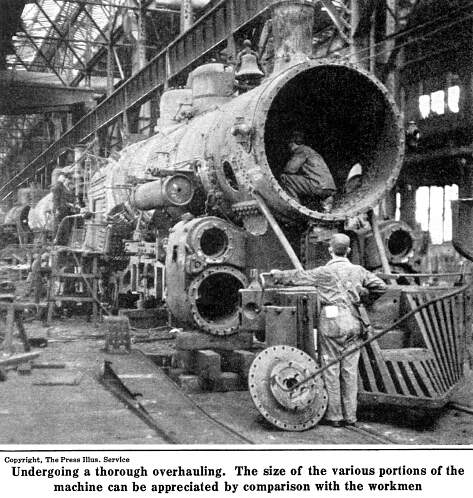 The failure of our railroads to
adequately perform the functions expected of them is, however,
not entirely the result of neglected motive power, for similar
conditions prevail in most everything connected with freight transportation.
The maintenance of freight cars has been slighted to a surprising
extent, and terminal facilities have by no means kept pace with
the increasing necessities of commerce; although in this matter
a considerable portion of the congestion may be attributed to
the custom of permitting consignees to delay unloading cars for
extended periods, thus using them for storage purposes instead
of promptly releasing them to perform their proper function as
transporters of freight. This latter abuse, it may be remarked,
has grown up as a result of competition between different roads
to secure business by extending privileges to shippers. A typical
case of this kind was recently noted in New York, where a number
of cars was reconsigned five times, each consignee holding the
shipment in the cars until he could resell the goods, the result
being that the cars were held out of legitimate service for several
months. The failure of our railroads to
adequately perform the functions expected of them is, however,
not entirely the result of neglected motive power, for similar
conditions prevail in most everything connected with freight transportation.
The maintenance of freight cars has been slighted to a surprising
extent, and terminal facilities have by no means kept pace with
the increasing necessities of commerce; although in this matter
a considerable portion of the congestion may be attributed to
the custom of permitting consignees to delay unloading cars for
extended periods, thus using them for storage purposes instead
of promptly releasing them to perform their proper function as
transporters of freight. This latter abuse, it may be remarked,
has grown up as a result of competition between different roads
to secure business by extending privileges to shippers. A typical
case of this kind was recently noted in New York, where a number
of cars was reconsigned five times, each consignee holding the
shipment in the cars until he could resell the goods, the result
being that the cars were held out of legitimate service for several
months.
That such conditions should exist may seem surprising to most
people, who have been regaled with glowing accounts of the phenomenal
abilities of the officials who control our roads, and the wonderful
growth of the roads they operate. As a matter of fact growth of
our roads has been due entirely to the growing demands of the
commerce of our country, and in spite of their methods of management.
Without question, there have been many men of unusual natural
ability in charge of the railways of this country; but results
tell their own story, and the serious breakdown of our railroads
under the emergency demands of war conditions shows conclusively
a great lack of scientific and efficient management, not for the
time being, but extending back many years. Indeed, our railroads
offer a great field for the efficiency expert.
That some of our railroads have provided modern facilities
for caring for their motive power is shown by the accompanying
illustrations, which indicate the character of the work that has
frequently to be done, and which give an idea of the magnitude
of the task.
Build a Locomotive
| Contents Page
|







